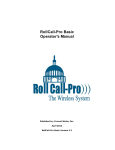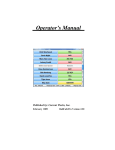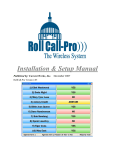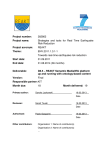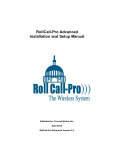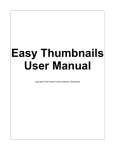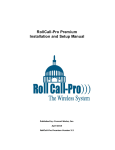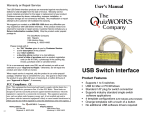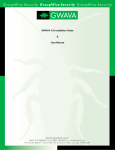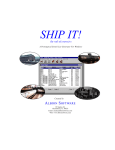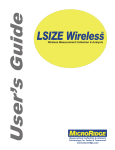Download RollCall-Pro Basic Operator`s Manual
Transcript
RollCall-Pro Basic Operator's Manual Published by: Current Works, Inc. July 2010 RollCall-Pro Basic Version 3.0a Contents 3 Table of Contents Part I Purpose of this Manual 4 Part II Site Setup 4 Part III Starting the RollCall-Pro System 5 Part IV Using the RollCall-Pro System 8 1 Keypad ................................................................................................................................... and Screen Controls 8 Voter Keypads.......................................................................................................................................................... 9 Leader’s Keypad .......................................................................................................................................................... 9 Leader Program .......................................................................................................................................................... Options 11 2 Roll Call ................................................................................................................................... 11 3 Discussion ................................................................................................................................... 14 4.4.2 Vote Passing .......................................................................................................................................................... Criteria 15 4.4.4 Present and .......................................................................................................................................................... Absent 15 4 Roll Call ................................................................................................................................... Voting 16 5 Results ................................................................................................................................... of Vote 18 6 Reveal ................................................................................................................................... and Record the Vote 19 7 Continue ................................................................................................................................... or Exit 21 8 Results ................................................................................................................................... Saved from a Meeting 22 Part V Trouble Shooting and Customer Service Index 23 25 © 2011 Current Works, Inc. 3 4 1 Purpose of this Manual This Operator’s Manual describes how to use the RollCall-Pro System, both the software and the wireless SideKeys keypads, in a meeting. It presumes that you have already used the Installation and Setup Manual to install the RollCall-Pro software program and to create the Configuration Files you will use in a meeting. You should also become familiar with the SideKeys User Manual that came with this System. This manual provides valuable information regarding the setup, maintenance and trouble shooting of the wireless keypad system. 2 Site Setup The following diagram and picture illustrate how to set the system up to work in a City Council Chamber, County Commissioners Room, Board Room, or any room where the system may be used. Possible scenarios are LCD or large TV monitors hanging in the room, or a projected display of the computer screen onto a white wall or drop-down screen, or a number of other display possibilities. The projection device can either be a portable system or a permanent projector hanging from the ceiling. Figure 2-1. Typical Hardware Setup © 2011 Current Works, Inc. Site Setup 5 Figure 2-2. Typical Installation of RollCall-Pro System Hardware 3 Starting the RollCall-Pro System Before starting the RollCall-Pro program for use in a meeting, we recommend that you adjust the computer so that it will not automatically go to a screen saver, to sleep, to hibernation or shut down the screen or any other power saving options. In a normal meeting, there may be extended periods of time when the computer and the RollCall-Pro System will not be used, and you do not want the computer to shut down any functions during the meeting. These power-saving shutdown functions could disrupt the RollCall-Pro software program or the USB connection to the wireless keypads and might require you to re-start the software program or the computer in the middle of a meeting. In the “Control Panel” of your computer, look for options under “Display Properties”. In the “Screen Saver” tab, choose “None” for Screen Saver: Figure 3-1. Control Panel’s “Display Properties” © 2011 Current Works, Inc. 6 In the “Control Panel” of your computer look for options under “Power Options”. In the “Power Options” choose “Never” for all options, including: Turn off monitor Turn off hard disk System standby System hibernate Figure 3-2. Control Panel’s “Power Options” Note: If you are using a Laptop Computer, always have the computer plugged into an external power source; it is not recommended to run this program off of batteries. Special Note: If you are using a Dell™ computer you may also need to use a USB Hub with an external power supply between the computer and the USB SideKeys Receiver. This will ensure that the required standard 5 volts of power is always available to the SideKeys Receiver. Also in the “Control Panel” of your computer, look for options under “Display”. Click the "Advanced" tab in the Display Properties dialog box: Figure 3-3. Control Panel’s “Display” Options © 2011 Current Works, Inc. Starting the RollCall-Pro System 7 The "Screen Resolution" option should be set to 1024 by 768 pixels, and the "Color Quality" option should be set to 32 or 16 bit, not 8 bit. Also on the Display Properties dialog box, click on the "Advanced" button. There, the DPI Setting should be 96 DPI, not 120 DPI: Figure 3-4. Display Properties DPI Setting Click "OK" to close the Display Properties dialog box. To start RollCall-Pro program, double-click on the icon on your desktop: The shortcut will open the RollCall-Pro System, and display its Welcome Screen: Figure 3-5. RollCall-Pro System Start Screen © 2011 Current Works, Inc. 8 Click this Screen’s “Start” button, choose a saved configuration, and “Open” it. If you need to make changes in the Configuration File, right-click in the application screen to display a list of options; select ‘Hide/Unhide Tabs’, then select the Setup to modify your configuration as needed. See the RollCall-Pro Installation and Setup Manual for details about these options. Update your Configuration as necessary. Don’t forget to Save your changes. 4 Using the RollCall-Pro System The RollCall-Pro screen displays as below: Figure 4-1. RollCall-Pro Display Screen Notice the last row at the bottom of the screen. The first field indicates the current item or issue. The middle field indicates the action to be taken (roll call, discussion, voting, etc.). The third field indicates the criteria required (Majority, 2/3, ¾, No Vote Req’rd, Custom) for the current item to pass. The small ">" button at the far right-hand side of the screen can be clicked with the mouse to "Proceed" (advance the program) through the Meeting Cycle (Roll Call, Discussion, Voting). 4.1 Keypad and Screen Controls The keypads and program options are used to move the participants through the voting session. © 2011 Current Works, Inc. Using the RollCall-Pro System 4.1.1 Voter Keypads Each voter will have a keypad like this one: Figure 4-2. Wireless Member Keypad Each voter has a wireless keypad with 4 active buttons for Yes (and Present), No, Abstain, and Confirm. Each of these functions will be discussed in detail below. 4.1.2 Leader’s Keypad The Leader will have a keypad like the one illustrated here: © 2011 Current Works, Inc. 9 10 Figure 4-3. Wireless Leader’s Keypad The Leader’s keypad has six buttons for controlling the functions of RollCall-Pro: 1. The Proceed button (top left, green button on the keypad) advances the RollCall-Pro software through the meeting. This will be explained in detail below. This “Proceed” function can also be accessed from the computer running the software program: either with the “z” key on the keyboard or by “Left-Clicking” the mouse cursor on the small “ > “ icon in the bottom right corner of the Display screen: 2. The % to Pass button adjusts the criteria to pass the Item being voted on. This function can also be accessed from the computer – either by using the “Period” (“ . “) key on the keyboard or by “Left-Double-Clicking” the cursor on the Criteria field in the lower right corner of the display screen during the Discussion mode of the meeting: 3. The Swap button allows the Leader to switch between the RollCall-Pro software program and any other software application, like PowerPoint, an Excel Spreadsheet, or a Word Document. 4. & 5.The Next and Back buttons allow the Leader, when in PowerPoint Slideshow presentation, to remotely advance the presentation, forward and back, respectively. 6. The Lock Out button locks out all other wireless keypads, except the Leader’s keypad. © 2011 Current Works, Inc. Using the RollCall-Pro System 11 This is useful when the Leader needs to stop the use of keypads for any reason. (e.g., when the Clerk needs to type in revisions to the Agenda during a meeting, or when a vote must be Cancelled, or when a Word doc is projected and you don’t want text from the keypads inserted, or when a PowerPoint presentation is being given and some text input might interrupt the presentation). Use of these functions will be discussed in further detail below. 4.1.3 Leader Program Options The Leader will also have a desktop or a laptop computer from which the RollCall-Pro software is executed, updated, and Results saved. There are several functions available to the Leader by clicking the mouse on the RollCall-Pro display screen. To initially access these options, simply right click anywhere on the display screen for the popup window of options. Then left click on the choice inside the pop-up window: Figure 4-4. “Right Click” Pop-up Menu Screen 4.2 Roll Call 1. To begin the meeting the Leader will push the “Proceed” button on the Leader’s wireless keypad, or the “z’ key, or click “ > “ to display the Roll Call Screen, ready for Members’ input: Figure 4-5. Initial Start up Screen © 2011 Current Works, Inc. 12 Figure 4-6. Ready for Members’ Roll Call input 2. The Voting Members push their “Yes (Present) button and then their “Confirm button to indicate their “Presence” in the initial Roll Call for the meeting. The screen will display the Present members and count the numbers of Voters logged in, versus the minimum quorum required. Figure 4-7. Member's Keypad © 2011 Current Works, Inc. Using the RollCall-Pro System 13 Figure 4-8. Roll Call in process 3. After all the Members who are actually Present have Confirmed their Presence, the Leader presses the Proceed button again on the Leader’s keypad (or hits the “z” key or clicks on the “ > “ icon). The Voting Screen will display those who are “Present” and those who are “Absent”. Note: The Keypads of those “Absent” members can not be used to mark them Absent. They automatically become Absent when the program is advanced with the Proceed function: Figure 4-9. Roll Call completed at beginning of meeting © 2011 Current Works, Inc. 14 Note: The meeting can continue only if the number of voters present equals or exceeds the Quorum number set in the configuration file as the minimum number of members required for the meeting to proceed. 4. If there are not enough members for the meeting to continue, the bottom center field will indicate that there are insufficient members for the meeting to proceed: Figure 4-10. Message indicating a Quorum is not yet present 5. If there are at least the Minimum Number of Voting Members to conduct business, the screen will display the Members “Present” and those “Absent”. A record of the Members who are “Present” and “Absent” during this Roll Call is also documented in the Results file for this meeting. 6. If a Member arrives late to the meeting after the Roll Call is completed, they can be marked Present by the Clerk. The actual time they are marked Present is Time Stamped in the Results File. 4.3 Discussion After the Startup Roll Call is completed, the Leader pushes the Proceed” button (or the z” key or clicks the “>” button) again to display the Discussion Screen for the first agenda Item: Figure 4-11. Discussion Screen © 2011 Current Works, Inc. Using the RollCall-Pro System 4.3.1 15 4.4.2 Vote Passing Criteria If necessary, the leader can change the Vote Passing Criteria displayed in the third field at the bottom of the screen by pushing the “% to Pass button on the Leader’s keypad, or by pressing the period “.” key on the computer keyboard. Either of these will scroll through the standard options until the desired choice is displayed in the field: Majority Vote (51%), 2/3 Vote (67%), 3/4 Vote (75%), or No Vote Req’rd. If you wish to change this Voting Criteria to a fixed number of Yes votes to pass, you must double left-click on the Passing Criteria field (bottom right corner of screen) during the Discussion phase, prior to the Vote. When this Passing Criteria is accessed by double left clicking the mouse, after the “No Vote Req’rd” criteria appears, the next double click will provide a popup window into which you can input the “Number of Yes Votes” required to pass the Item, regardless of how many voters are present: Figure 4-24. Entering a Fixed Number of “Yes” Votes require to Pass the Item Note: The Number of "Yes" Votes needed to Pass must be between the Quorum Required and the Number of Voting Members present at the meeting. Once the leader enters the "Number of Yes Votes" and clicks "OK", the Vote Passing Criteria displayed in the third field at the bottom of the screen updates: 4.3.2 4.4.4 Present and Absent The Leader has an overriding function that can be used to change the “Present/Absent status of any Member during the “Discussion” phase of a meeting. If a Voting Member leaves the meeting, the Leader can double-left click on the Member’s Name and a small pop-up message window will appear. In the example below, the Leader double-clicked on “Doris” and the following message popped up. To change Doris’ display to “Absent”, click “Yes”. To leave things as they are, click on “Cancel”. © 2011 Current Works, Inc. 16 Figure 4-12. Clerk changing Present to Absent Once the Leader chooses “Yes”, the display will look like the following: Figure 4-13. Member status after being marked Absent Note: This same sequence can be used to change the “Absent” status back to a “Present” status. This “status change” function can only be done by the Leader during the “Discussion” phase of the meeting. 4.4 Roll Call Voting The members vote on the Item by first pushing their Voting buttons: Yes, No or Abstain. Then the Members lock-in their vote by pushing the Confirm button. Note: Members can change their mind on how they wish to vote until they push their Confirm button. At that point, the last choice they made, just before Confirm, is locked in. The Voting screen will first display “Confirming” on a yellow background when each member pushes their Vote button: When they lock-in their vote with the Confirm button, the Voting screen displays “Vote Locked”: © 2011 Current Works, Inc. Using the RollCall-Pro System 17 Note that the votes are identified by the ‘Confirming’ and ‘Vote Locked’ status, not by a ‘Yes’ or ‘No’ or any other indication of how each member voted. This allows everyone to vote without being unduly influenced by how others have voted: Figure 4-14. Voting in Process Cancel the Vote: This system also has an option is to Cancel the entire Vote, if necessary, before the votes are officially revealed. If there is a reason to cancel the vote and start back at the Discussion of the Item, before the final vote is revealed, the Leader must right click anywhere on the screen to get the popup screen of options. One of these Options is “Cancel Vote”: Figure 4-15. Right-Click Popup Options Left Click on the “Cancel Vote” menu option, and then the system will ask you to confirm your cancellation: Figure 4-16. Are you sure? © 2011 Current Works, Inc. 18 Select “Yes”, and the program will then return you to the Discussion phase of the Current Item. 4.5 Results of Vote Once all votes are in and confirmed, the individual votes are displayed next to each voter’s name: Figure 4-17. Vote Tally When the Votes are revealed, the field at the bottom of the screen displays the status of the vote, whether it “Passed” or “Failed”. The number of ‘Yes’ votes required to pass an item or resolution depends on the “Criteria to Pass” selected and displayed at the bottom right corner of the screen, before the vote was started. If the First Position Voter is designated in the Business Rules to only vote in case of a tie, she/he does not vote unless a tie is indicated. In case of a tie, the Voting Screen will indicate the need for the Tie Breaker to vote. The specific votes of other Voting Members are not displayed until after the Tie Breaking vote is cast: © 2011 Current Works, Inc. Using the RollCall-Pro System 19 Figure 4-18. Tie Breaker Voting Required and the Votes are Revealed The Member designated as the tie breaker then casts his/her Yes or No vote and then presses Confirm to lock in the final vote. Once the tie breaking vote is locked, the individual votes are all displayed, as usual. 4.6 Reveal and Record the Vote Once the votes are cast and displayed, the Leader again pushes the Proceed” button to confirm that it was a good vote. The next step in the program is to record the results (if the Configuration File requires the recording of the results). © 2011 Current Works, Inc. 20 The screen below indicates that RollCall-Pro is in the process of recording results: Figure 4-19. Recording Results in the record The results will be saved as a text file: Figure 4-20. Results Document in Text Format © 2011 Current Works, Inc. Using the RollCall-Pro System 21 This Results file indicates that for Item 1 a total of 8 votes were cast; that Members 2 & 4 were Absent for the Discussion and the vote; that 5 voted in favor, 2 were opposed, and 1 abstained. The RollCall-Pro System results file is created and the name of the file is embedded with the current date (Example: “2_15_2009_1925.txt” means that the meeting started at 7:25 pm on February 15, 2009.) If an additional meeting is held on the same date, the software first checks to see if a results file exists for the current date and if so, prompts the user to either append the results to the current results file or to add another new results file in the Results Folder: Figure 4-21. Select Yes = Same meeting, or No = New meeting For example, if the user chooses to create a new results file by choosing “No”, then a new results file is created, with the time added to the date in the new document's name. For example, if the date was February 15th, 2009, and the time was 8:15pm, then a new results file would be created with the name of “2_15_2009_2015.txt”. Note the time is in military format, or 24 hour notation. 4.7 Continue or Exit Continue with a discussion and a vote on another item by clicking on the Leader’s Proceed” button; or, if the meeting is finished, exit RollCall-Pro by right-clicking on the screen to display the list of options, then selecting the ‘Exit Voting Pro’ option: The “Are you sure?” window pops up to confirm that you wish to Exit before proceeding: Figure 4-22. Exit RollCall-Pro Process © 2011 Current Works, Inc. 22 If there are unsaved Voting Results that did not yet get recorded, the following window will also popup to request that you proceed to save the Results before Exiting the program: Figure 4-23. Exit, After Saving Results When the RollCall-Pro software is closed through this “Exit” function, the End of the Meeting is also Time Stamped in the Results document. 4.8 Results Saved from a Meeting If, in the Setup Configuration Files, the “Record Results” has been selected, they will be saved at the location specified. The Default location is in (C:\RollCall-Pro\Results). The RollCall-Pro software program will automatically install a shortcut on your desktop to the “RollCall-Pro Folders”, where the Results Folder is located: The saved file will be labeled according to the date of the meeting (e.g. 10_05_2008.txt). This report, which is a “text file” (.txt), can be copied and pasted into any other Word Processing program, like MS Word, to become a part of the recorded Minutes of the meeting. Note: You may go view the saved Results document before the meeting is finished, but you must close the Results document down before returning to the meeting, where additional Voting Results will be saved. The Voting Results cannot be saved to an “Opened” document and in some cases, an “Error Message” may occur when the program tries to save additional Voting Results to a document that is opened. © 2011 Current Works, Inc. Trouble Shooting and Customer Service 5 23 Trouble Shooting and Customer Service If the RollCall-Pro software program does not seem to be responding to signals from any of the wireless keypads, the following trouble shooting steps should be tried, in the order given: 1. Be sure that the RollCall-Pro screen is active and available to accept input from the keypads. Left-Click the mouse on theRollCall-Pro screen to assure it is active; try the keypads again. 2. Be sure the keypads are not “Locked Out” by the Leader’s keypad. a)The red LED on the Receiver blinks on and off when the Lock-Out function is on. b)Turn off the “Lock-Out” by pushing the “Lock-Out” button on the Leader’s keypad. 3. Be sure that the USB Receiver is properly connected to the computer. a)The red LED should be glowing next to the RollCall-Pro label on the Receiver. b)If the red LED is not on, unplug and re-plug the USB cable at both ends, just to be sure that full and proper connections are being made. c)If the red LED is glowing, but is not next to the Voting-Pro label, push the small red button on the side of the Receiver (if there is one) to scroll the LED to the RollCall-Pro or the Voting-Pro template. d)The USB cable connecting the computer and Receiver should be uncoiled, free to dangle. e)This Radio Frequency Receiver cannot be resting on a metal surface; try moving it to different locations. If some of the keypads do not seem to work, try the following trouble shooting steps: 1. Try installing new “alkaline 9-volt batteries” in the defective keypad(s). 2. Be sure that all the Voting Members have the correct keypad. If Voters have the wrong keypad, they may think their keypad is not working properly. 3. The Radio Frequency keypads cannot be resting on a metal surface; this will seriously limit the range of the radio frequency signal. Try moving it to another surface. © 2011 Current Works, Inc. 24 If none of the keypads or the mouse or the keyboard works on the software, be certain that all sleep, hibernation and power saving settings are turned off on the computer. If the RollCall-Pro software will not advance when the “Proceed” button on the Leader’s Keypad or the “z” button on the computer keyboard is hit – be sure that the Caps-Lock key has not been depressed. You must turn off the Caps Lock key, before the software will respond to keystroke inputs. If the problem cannot be fixed with these steps, please contact Customer Service: Current Works, Inc. 1395 Horizon Drive Johnsburg, IL 60051 1 (888) 526-1200 Email: [email protected] www.rollcallpro.com © 2011 Current Works, Inc. Index Index -RRecord the Vote 19 Results of Vote 18 Results Saved from a Meeting Reveal the Vote 19 Roll Call Phase 11 Roll Call Voting 16 -AAbsence and Presence 15 -C- -S- Continue or Exit dialog 21 Criteria for Passing 15 Customer Service 23 Saved Results 22 Site Setup 4 Starting the RollCall-Pro System -DDiscussion Phase Trouble Shooting Using the RollCall-Pro System -KKeypad and Screen Controls Keypad, Leader 9 Keypad, Voter 9 8 -L11 -MMeeting Cycle, Discussion 14 Meeting Cycle, Roll Call 11 Meeting Cycle, Voting 16 -PPresent and Absent 15 Purpose of this Manual 4 © 2011 Current Works, Inc. 23 -U- 14 Leader Program Options Leader's Keypad 9 5 -T- 14 -IItem Discussion 22 -VVote Passing Criteria Vote Results 18 Voter Keypads 9 Voting Phase 16 15 8 25


























